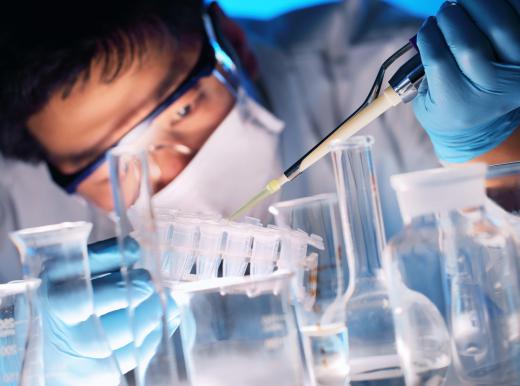What Is the Law of Definite Proportions?
The law of definite proportions, first explained in the late 1700s by the chemist Joseph Proust, is the foundation for modern science's understanding of chemical combinations. It says that, in any volume or mass, the elements of a chemical compound will maintain their set proportion. For example, a commonly known chemical compound is pure water, made up of hydrogen and oxygen in the formula H2O. The law of definite proportions says that regardless of the quantity of water — whether a glass, a rain barrel, or an eyedropper — the ratio of hydrogen to oxygen will always be one part hydrogen to eight parts oxygen. This law applies to the proportions of almost all chemical compounds.
Proust discovered the law while conducting experiments to determine the formulas of chemical compounds. His experiments over a six-year period were initially on metal compounds, and his conclusions differed from the established science of the day. Proust's discoveries were strongly contested by other scientists. It is believed that this reaction was due to confusion on the part of most 18th century scientists about the differences between pure and mixed chemical compounds.

One scientist who did not disagree with Proust was John Dalton, who at the same time was developing his theory of the law of multiple proportions. Coming at the principle from a different avenue, he noticed that when compounds were made using differing methods, their ratios were directly proportionate to the original compound elements. Further, he claimed these ratios were always expressed as whole numbers. When he heard Proust’s law of definite proportions, he realized that this law, combined with the law of multiple proportions, formed the basis of the earliest atomic theory, which explained the behavior of atoms according to fixed laws.
Today, scientists consider the law of definite proportions a critical scientific discovery. It is not, however, universally true. There are some chemical compounds that combine outside of the strict proportions of this law. In the 18th century, experimentation was not as precise as it would become in later centuries; measurements were not reported with enough exactitude to notice variations among the elements known at that time. Additionally, isotopes and their influences upon compounds had not yet been discovered. Factoring the impact of light and heavy isotopes into the analysis of atomic weights can account for the exceptions to the rule.
AS FEATURED ON:
AS FEATURED ON:











Discussion Comments
@jcraig - That is an interesting point. Reading articles like this always makes me think about where we currently stand in the world of science. Of course, there are a lot of science fiction ideas that get thrown around in movies and books, but I always wonder what science will be like in 200 more years.
I highly doubt Proust and Dalton envisioned computers and airplanes, so I'm sure a lot of our guesses about the future are way off.
You would have to assume that a lot of the things we think are groundbreaking discoveries today, like the experiments at CERN, will be common knowledge in a couple centuries.
@stl156 - Good question. I think by the time these experiments were going on scientists agreed upon what elements made up certain compounds. The dispute was more about how many of each atom was in each molecule. Other scientists would have argued that as long as hydrogen and oxygen were together and conditions were right, they could make water.
I don't have any idea how exactly Proust proved his theory, but I'm guessing he knew that the weight of a certain volume of different substances never changed. With that, he could mix together different compounds and weigh the byproducts and finally arrive at the conclusion that different compounds have unique molecular structure.
Obviously, Proust's methods were very sophisticated for the time. Today, even school children take for granted the fact that water is always in the form of H2O. Back then, even well respected scientists couldn't figure this out.
How was it that when these scientists were working over 200 years ago, they were able to figure out what the proportions of different compounds were without using the sophisticated measuring techniques we have today?
Also, how long did it take for the scientific field to recognize that Proust and Dalton were right? I know back then coming up with a radical theory was often met with opposition and could even get you in trouble in some cases.
Very interesting. I know when I was taking chemistry in college, they never mentioned that sometimes the law of definite proportions could be violated in special circumstances. I'm sure it was beyond what we needed to know at the time.
I am interested, though, what exactly are some of the compounds that don't adhere to the rules? How do isotopes and light cause compounds to form differently?
Post your comments